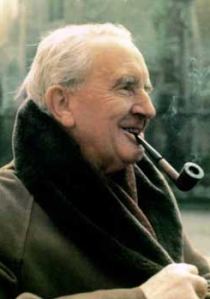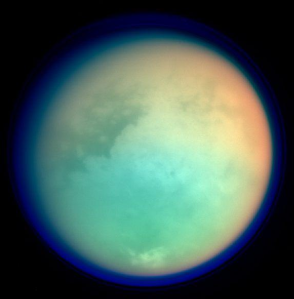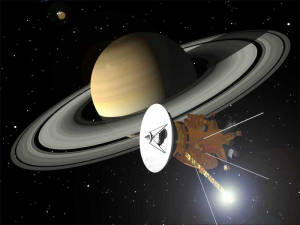Tolkien on Titan: Fantasy Fiction and Solar System Nomenclature
02/06/2014
As the Second World War closed in around Britain and the V2 rockets fell from the skies, an avuncular Oxford don sat in his study and scribbled out stories of goblins and elves and hairy-footed analogues of the rustic English country-folk. It was a fiction derived from his own experience of total war some two decades earlier but one which in retrospect, and despite the author’s efforts, assumed an allegorical relationship to the European conflagration igniting all around him. Almost sixty years later, an interdisciplinary fellowship of some 200 scientists and engineers, some of them operating out of Oxfordshire’s Rutherford Appleton Laboratory, watched the launch of a Titan IV heavy-lift vehicle – ploughshare to von Braun’s first swords – as it carried the last of the great interplanetary exploration craft away from Cape Canaveral in Florida. That probe, Cassini-Huygens, would travel billions of miles into the Outer Solar System where, after seven years of space flight, it eventually arrived high above JRR Tolkien’s Middle-earth.
Or at least high above Titan, Saturn’s largest moon, where the mountains and mountain ranges are named after those in Tolkien’s genre-defining novels The Hobbit (1937) and The Lord of the Rings (1954, 1955). Discovered by the Dutch astronomer Christiaan Huygens in 1655, the tantalizing Titan, which is larger by volume than the planet Mercury, was one of the Cassini probe’s key targets in the realm of the ringed world, as well as the final destination of the European Huygens lander which the NASA mother-craft bore like a hobbit upon a man’s back. Yet for all its currently recognised promise, the moon attracted little scientific interest until a second Dutchman, this time Gerard Kuiper (he of the Kuiper Belt), used spectroscopy to identify the presence of methane and nitrogen in its atmosphere in 1944, just as the pipe-smoking Tolkien began to “tackle the journey of Frodo to Mordor”. Further analysis revealed the moon’s atmosphere to be a dense soup of organic molecules, most likely similar to the primeval, pre-biotic atmosphere of Earth some four billion years ago. It is a blessing which obscures all surface detail in a foul orange smog and, though the Pioneer and Voyager missions passed through the Saturn system in the early 1980s, the geological character of Titan was virtually unknown before the arrival of Cassini’s cloud-penetrating radar in 2004.
At five-and-a-half tons, the Cassini spacecraft is one of the largest and most complex interplanetary probes ever devised. This heavily instrumented robotic platform required 13,000 work-years by US and European scientists to construct, which, for comparison, is about half of what it took to build Egypt’s Great Pyramid of Cheops. Like Tolkien’s Ring of Power it is also a poisoned chalice of sorts. With solar cells all but useless at a distance ten times further from the Sun than that at which Earth orbits, the great potential of Cassini was realized only at the cost of a radioisotope thermoelectric generator. Plutonium, in other words (and just imagine what Tolkien’s Sauroman, the industrializer of green valleys with “a mind of metal and wheels”, might have done with a pellet of red-hot Plutonium-238). Environmentalists went to court to halt the launch on account of the risk that the probe could explode on take-off or crash into Earth on its gravity assist flyby, scattering toxic fuel into the upper atmosphere and threatening hundreds of thousands of people with radiation poisoning. NASA deemed this “scaremongering” given how the craft’s 32.6 kilograms of plutonium dioxide were housed in an iridium and graphite-encased module – a casing insoluble in water and almost impervious to heat – which would, in the case of an accident, simply fall to Earth unbroken for later recovery. The court agreed, the launch went ahead, and two years later, in August 1999, Cassini blasted past Earth for the last time at an altitude of 700 miles to gain a much needed 12,000 miles-an-hour boost in its velocity.
On July 1st 2004, just 28 days short of the 50th anniversary of Tolkien’s masterpiece, Cassini completed its Saturn insertion burn, arching between two of the giant world’s majestic hoops of dust and ice as its main engine ignited for 96 minutes to place it into orbit of the sixth world from the sun. Its objective, in the words of Jet Propulsion Laboratory director Charles Elachi, was “to allow us to rewrite the story of the Lord of the Rings”. It was an obvious joke to make given the Saturn system’s defining characteristic but, nonetheless, is one which betrays how the fantasy epic was very much on the mind of the Cassini mission’s primary investigators. No surprise so that, on December 5th, 2011, the Working Group for Planetary System Nomenclature (WGPSN) announced the following six Tolkien-inspired names for Titan features discovered by Cassini’s radar: Angmar Montes, named for Ângmâr, the home of the Witch-King and the leader of the Ringwraiths; Dolmed Montes, named for Dolmed in the Blue Mountains, beneath which two of the Dwarf Fathers are said to have awoken; Echoriath Montes, in honour of the Encircling Mountains; Gram Montes, after a Misty Mountains peak adjoining the Shire; Merlock Montes, commemorating a summit mentioned in an eerie Hobbit nonsense poem; and Rerir Montes, named for a mountain fortress abandoned after the War of Wrath in Middle-earth’s Second Age.
A further sitting of the WGPSN authorised the following seven names on November 13th 2012, just as the first part of Peter Jackson’s adaptation of The Hobbit was about to hit cinemas: Erebor Mons, in honour of the Lonely Mountain where Bilbo Baggins first found adventure; Irensaga Montes, an equatorial range named after one of the White Mountains; Mindolluin Montes, just west of the landing site of the Huygens probe and named for a peak overlooking Minas Tirith, the City of the Kings; Misty Montes, whose name requires no explanation for Tolkien fans; Mithrim Montes, honouring the place where the High Kings of the Noldor, the Elves of the second clan, raised their halls; Taniquetil Montes after the Holy Mountain in Tolkien’s Undying Lands, the highest peak in all of his imagined world’s history; and finally Doom Mons, named for the great volcano where the Ring of Power was forged by Sauron and where, at the climax of The Lord of the Rings, it is ultimately destroyed.
Formed at the 1973 Sydney meeting of the International Astronomical Union, the WGPSN typically assigns names in Latin, a policy designed to foster linguistic neutrality but one which has, inadvertently, fermented a certain distance between the general public and the places in question. Henrik Hargitai and Kira Shingareva’s excellent discussion of the WGPSN’s history defines two major functions of the current planetary nomenclature system: one is a “cultural function” commemorating individuals from across human history; the second, the so-called descriptor element of the name, is to represent “the true nature of the geographic (landscape) feature”, its morphology, and in some cases, its geological origin.
Yet in Titan’s case, the realities of the surface features belie the grandeur of the names attached to them. Information from the Cassini and Huygens craft tell us that the moon’s mountains are little more than 1.25 miles from base to peak – comparable to the taller summits of the Appalachians – and are most likely made of water ice. They are, in other words, a far cry from the rocky, soaring ranges of Middle-earth. Then again, given that the correlation is an arbitrary one by any objective measure, this is to be expected and, more thought-provoking than a mere geological compare-and-contrast, is the manner by which the WGPSN’s choices speak very clearly about our relationship to Tolkien’s fiction. For instance, Doom Mons is Titan’s largest mountain by volume, and possibly its highest by height (that remains to be determined) but in Tolkien’s legendarium it is Taniquetil, not Mount Doom, which is the greatest mountain in the world. Because of its prominence in The Lord of the Rings however (and doubtlessly aided by its evocative depiction in Peter Jackson’s film adaptations, released during Cassini’s “cruise phase”), it is Mount Doom, not distant Taniquetil, which looms largest in the public imagination – and so now on Titan – as the greatest mountain.
A further connection between Titan and Middle-earth exists in the fact that, though Tolkien occasionally described his creation as a secondary world, he most often figured Arda (that being what was generally considered to be Earth itself, the planet on which The Lord of the Rings is set) as a distant geological epoch of our world, the rolling hills and rich countryside of the prelapsarian Shire eventually becoming the familiar landscape of north-west Europe. In the same way, the organic chemistry of the pre-biotic Titan resembles a long-past chemical epoch of Earth’s history. It does not necessarily contain the same kind of ingredients (for example, Titan is oxygen-poor) but it allows us to observe the same kind of reactions which led to the appearance of the first organisms here on Earth.
Tolkien too shared a concern with the origins of life, albeit one which was less chemical than it was poetic. In his posthumous volume The Silmarillion (1977) he depicts the awakening of the Elves and, much later, the coming of men. In the case of the former, they gain awareness beneath the light of a familiar sky. Tolkien conceived of a solar system, or perhaps we should say the Solar System, in similar terms to how he figured Arda, portraying recognisable bodies as they might be perceived from the vantage of the real world. He called this cosmos the “Ilmen”, derived from a Finnish word for “air”, a “stellar kingdom” through which the stars and planets (the author did not distinguish between them) moved “like translucent lamps set quivering above the world”. For the most part, Tolkien portrayed identifiable constellations like Orion, “Swordsman of the Sky”, as created by Varda, one of the Valar, or the elemental world spirits who play such a part in The Silmarillion, and a being known the Queen of the Stars to the elves. Tolkien’s son and literary executor Christopher, who has done considerable work in making the early drafts of his father’s legendarium available via the twelve volume History of Middle-earth, conjectures that among the celestial bodies attributed to Valar, it is “Lumbar” – deriving from the Elvish “Lumbule”, meaning “clouds” – which represents Saturn, or at least did for a moment’s amusement. The name does not make its way into the texts published in his lifetime but appears, as part of a list of other lights in the night sky, among the pages of The Silmarillion.
Nonetheless there exists here a relationship whereby an author takes a real place and creates a fantasy version of it only to inspire his readership, a half century later, to recast elements of that real place after the fantastical mould. Perhaps it speaks to a human desire to reassure the imaginative aspects of ourselves that impossible worlds of wizards and magic might actually exist somewhere? Investigating this urge in the 1970s, Mary Lou Colbath, then a graduate student at the University of Maine, pointed out that the history of western civilization is embroidered with names and legends cherished – and often created – by this “great need of generations long past”. In “an age of space travel and instant communication,” she said, there have been “too few heroes created for children” in particular. Ironic so that it is space travel and (nearly) instant communication which have allowed us regain access to heroic and rousing landscapes, the type of vistas which inspire children to become astronauts or engineers or, dare it be said, even fantasy novelists. Just consider how the examples Colbath provides of names which “alone call forth an age” are now themselves scattered across the Solar System: Ulysses, a Martian volcano, approved in 1973 (and modified in 2007 to refer specifically to the mountain’s caldera); Achilles, a crater on Tethys, approved in 2008; Beowulf, a near-Earth Asteroid discovered in 1999; Charlemagne, a crater on Iapetus, approved in 1982; Arthur, a crater on Mimas, another Saturnian moon, approved in 1982; and Lancelot a main-belt asteroid discovered in 1960.
Thus the nomenclature associated with planets and small Solar System bodies is, as Hargitai and Shingareva put it, a representation of the culture of its creators. Names chosen are often with a distinct mythological connotation, yes, but more and more they also display a literary origin (apparent in how geological features on the Uranian moons Miranda, Titania, and Oberon are named after characters and places from Shakespeare’s plays). In Titan’s case, the WGPSN reconvened a little over a month after the naming of Doom Mons to approve the names of smaller features, principally hills (known as colles) along Titan’s equator. For these they chose to draw on Tolkien’s dramatis personae: Arwen Colles, after the daughter of Elrond and the lover of Aragorn, one of the most lovely of all the Elves and so in keeping with Titan nomenclature’s emphasis on deities of beauty; Nimloth Colles, after a distant ancestor of Arwen; Handir Colles, an honour granted to an ancient but minor king of men; Bilbo Colles, after Tolkien’s titular Hobbit; and Faramir Colles after a prince of Gondor who, among the vast cast of The Lord of the Rings, is said to most resemble the author himself, wary of war but “a captain that men would follow”, a fair man with a great pride in the achievements of his people and his land.
If that is true then Tolkien might well have smiled at the English involvement in what is probably humanity’s last trip to Saturn in our lifetimes. Beginning with a Science and Engineering Research Council contribution of £5 million towards the mission in 1991, scientists at the universities of Oxford, Kent, Sheffield, and Imperial College in London helped design and run six of Cassini’s twelve instruments, as well as building another two for the Titan probe. On-board software was provided by the computer consultancy Logica in London, while the crucial Huygens parachutes were crafted by the hard-working Hobbits at ejector-seat manufacturer Martin Baker in Uxbridge. Together they constructed a vast machine and, along with scientists from 16 other nations, sent it billions of miles to a literal fantasy world in what has turned out to be an astounding memorial to the author who has touched the lives of millions.
Readers respond to Middle-earth so powerfully because it is what Brian Bates, professor of psychology at the University of Brighton, called (in the year of Cassini’s arrive at Saturn) “the landscape of our deep imagination”. The Cassini-Huygens mission has provided a window into that landscape, into a world more breathtaking and dazzling than anything which prose, even writing as inventive as Tolkien’s, can conjure up. From its telemetry we have even been able to produce sketchy maps of Titan which, like those accompanying the old don’s novels, are simultaneously ill-defined and instantly intriguing. Because like Middle-earth, we still only have glimpses at parts of the moon’s surface. It is fitting so that, as with the writing of The Lord of the Rings, the exploration of Titan is a story which has grown with the telling and, in Tolkien’s words, includes “many glimpses of the yet more ancient history that preceded it”. Indeed, it is difficult not to wonder what the Eagles or the Uruk-hai would think if they knew that we were spying on them from high in the Ilmen where “the stars wheeled over”. What would the Orcs, who prized cunning devices, do if they discovered the remains of the lander we deployed to Middle-earth? Smelt it down, perhaps? Forge from it some martial artifice with a glint of magic to it like?
Such questions, of course, are among those that Cassini-Huygens is not equipped to answer. Worse, we must admit that all things, stories and spacecraft alike, have an ending. For the Ring of Power it was obliteration in the Cracks of Doom, deep inside the territories of the Dark Lord. For Cassini it will be an equally fiery plunge to destruction within the domain of the Lord of the Rings, a final mission scheduled for 2017 where the probe will be deliberately vaporised in Saturn’s atmosphere. The reasoning for both final acts is similar. Cassini, with its plutonium and its otherworldly origin, is too dangerous to simply be discarded or forgotten. Its destruction is necessary to prevent contamination of moons such as Enceladus and Titan which may harbour the conditions necessary for life. An impossibility? Maybe. But then again, not that long ago it seemed impossible that we could ever send a satellite to Middle-earth.
____
Other posts which may be of interest:


